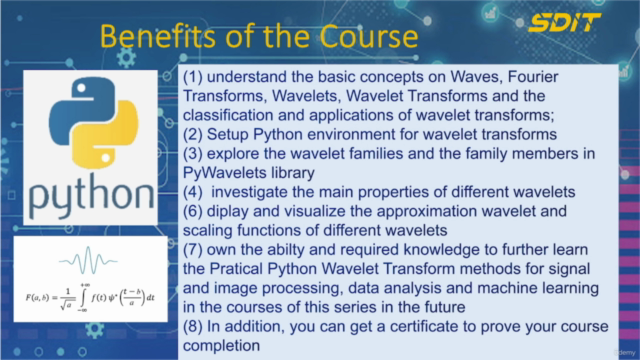Practical Python Wavelet Transforms (I): Fundamentals

Why take this course?
🌟 Dive into Practical Python Wavelet Transforms 🌟
What is Wavelet Transform (WT)? 📊✨
Wavelet Transforms are a leap forward from the traditional Fourier Transform, offering a profound way to analyze signals by breaking them down into different frequency components at different time instances. Unlike the Fourier Transform, which averages information over time, WT preserves the time localization of signal features. This is crucial for analyzing real-world data where both time and frequency resolutions are vital.
Real-World Applications of Wavelet Transforms 🌍🔬
- Noise Removal: Clean up your signals without losing essential details.
- Trend Analysis & Forecasting: Predict future trends with greater accuracy.
- Abrupt Change Detection: Spot unexpected changes or anomalies in data.
- Data Compression: Efficiently store large datasets, like images for JPEG2000.
- Data Encryption: Secure your data against unauthorized access.
- Machine Learning Enhancement: Improve the performance of ML models with wavelet features.
Course Overview 🎓🖥️
"Practical Python Wavelet Transforms (I): Fundamentals" is the first installment in a series designed to equip you with hands-on experience using Python and its libraries for wavelet analysis. Here's what you'll cover:
- Fundamentals: Get acquainted with the core concepts of Wavelet Transforms, including an introduction to various wavelet families and their functions.
- Discrete Wavelet Transform (DWT): Learn how to decompose signals into wavelets for discrete analysis.
- Stationary Wavelet Transform (SWT): Understand the continuous counterpart of DWT, ideal for stationary data.
- Multiresolutiom Analysis (MRA): Explore the mathematical underpinnings that allow us to analyze signals at different scales.
- Wavelet Packet Transform (WPT): Discover how to reconstruct a signal from its wavelet coefficients, offering more flexibility than DWT and SWT.
- Maximum Overlap Discrete Wavelet Transform (MODWT): Master the technique that provides improved resolution and time-frequency localization over traditional DWT.
- MODWTMRA: Combine MODWT with MRA for enhanced signal analysis capabilities.
Why Should You Learn This? 🤔🚀
This course is your stepping stone to mastering wavelet transforms in Python. It's designed to introduce you to the fundamental concepts and techniques, which are essential building blocks for more advanced applications in signal processing, data science, and machine learning. By completing this course, you'll have a solid foundation to tackle complex problems with confidence.
Important Note: This course is the entry point to the series but doesn't require prior knowledge of wavelet transforms. The free preview parts will give you a taste of what's to come in the subsequent advanced topics. So, are you ready to ride the wave of wavelets and transform your data analysis skills? 🌊✨
Enroll now and take your first step towards becoming a signal processing pro! 🚀📈
Course Gallery




Loading charts...